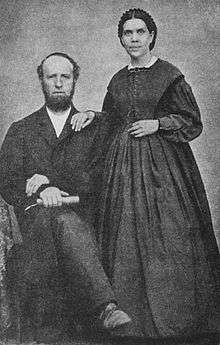Conflict of the Ages
| Part of a series on |
| Seventh-day Adventist Church |
|---|
 |
|
Adventism Seventh-day Adventist portal |
The Conflict of the Ages book series was written by American religious author Ellen G. White (1827-1915).
The books follow the Biblical history of the world, with special focus on the conflict between Christ and Satan. The series starts with the pre-creation rebellion of Satan in Heaven, then moves on to the creation of the earth, the fall of Adam and Eve into sin, the Old Testament, the birth and ministry of Jesus until His ascension, then the early Christian church, the Dark Ages, the Protestant reformation, the last days of earth's history, the second coming of Christ, the millennium, and the destruction of sin and finally the recreation of earth and God's kingdom with man for eternity. This progression explains in detail the SDA understanding of the conflict between Christ and Satan and their understanding of the Bible and much of world history. She wrote the books based on her research of other authors and special information which she claimed to receive through visions from God. The books thus include unique insights and concepts not found in other works of the time.
Books
Patriarchs and Prophets
Volume 1 covers from the rebellion of Satan in heaven to King David.
Prophets and Kings
Volume 2 covers events from King Solomon to Malachi.[1]
The Desire of Ages
Volume 3 covers the life and ministry of Jesus.
Acts of the Apostles
Volume 4 covers from the Great Commission to John the Revelator on Patmos.[2]
The Great Controversy
Volume 5 covers the 70 A.D. destruction of Jerusalem, through Church History, to the end of sin and the recreation of the earth.
Contemporary adaptations
Adaptations of the 5-volume Conflict of the Ages series have been produced, aimed towards updating the language yet keeping the meaning intact.
- Messiah is an adaptation of The Desire of Ages, by Jerry D. Thomas. Pacific Press; publisher's page
A complete series aimed at younger readers has been commissioned by the General Conference to complement the Cornerstone Sabbath School lessons in 2007–2011:
- The Beginning of the End, an adaptation of Patriarchs and Prophets. Pacific Press; publisher's page
- Royalty and Ruin, an adaptation of Prophets and Kings. Pacific Press; publisher's page
- Humble Hero, an adaptation of The Desire of Ages. Pacific Press; publisher's page
- Unlikely Leaders, from The Acts of the Apostles. Pacific Press; publisher's page
See also
- Steps to Christ
- The Desire of Ages
- The Great Controversy (book)
- Teachings of Ellen White
- Ellen G. White bibliography
- Inspiration of Ellen White
- List of Ellen White writings
- Seventh-day Adventist eschatology
References
External links
- Online versions from the Ellen G. White Estate website
- Connecting with Jesus resources from the church in North America. These include free audio downloads of contemporary adaptations of the Conflict series